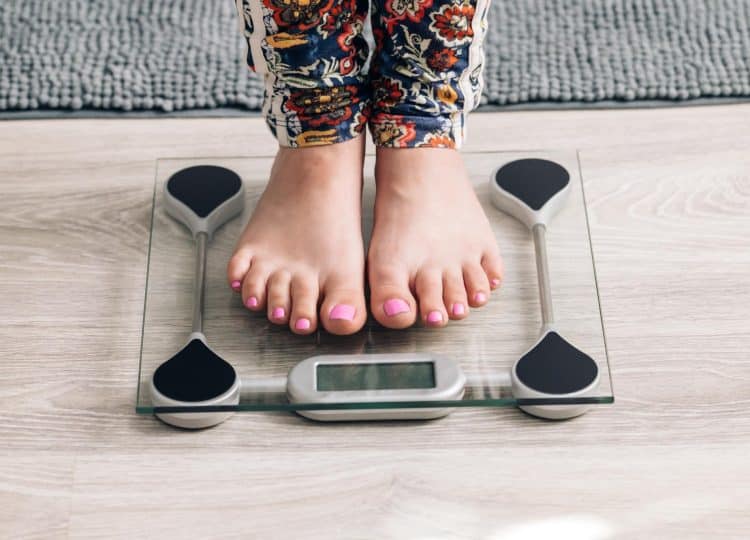January is a popular time for getting fit and losing weight. In fact, most gyms run “New Year, New You” promotions, hoping to cash in on this common trend. As a former gym owner, I welcomed the injection of cash that New Year brought and did all I could to help my new clientele achieve their fitness goals.
Sadly, research tells us that as many as 80% of New Year’s resolutions fail within six weeks (1). In my experience as a veteran personal trainer, I believe this is because most people take on too much at once. Others simply aren’t committed to making meaningful changes. They’d like to lose weight or get fit, but they don’t want it – there’s a big difference!
Subsequently, I recommend only making resolutions you are really passionate about and breaking big changes into smaller, more manageable chunks. For example, instead of trying to lose 50 pounds in eight weeks, commit to losing four pounds a month over the coming year. The end result will be the roughly same, but losing weight slower is more manageable and sustainable.
Not sure how to start your New Year on the right foot and make meaningful resolutions? In this article, I share some ideas for New Year’s Fitness resolutions to make in 2024.
Exercise Resolutions for 2024
Whether you are a beginner, lapsed, or experienced exerciser, these resolutions will help you reach your New Year fitness goals. Don’t try and do them all at once – that’s a recipe for disaster. Instead, pick the ones that resonate with you the most. You can always add more later in the year.
1. Master Your Body Weight
Level Up Your Fitness: Join our 💪 strong community in Fitness Volt Newsletter. Get daily inspiration, expert-backed workouts, nutrition tips, the latest in strength sports, and the support you need to reach your goals. Subscribe for free!
Exercisers often dismiss body weight or calisthenics training. They believe that it’s only effective for beginners, or for conditioning and fat loss. This is not the case.
In contrast, you can build muscle, strength, and power with calisthenics, even if you are already very experienced. After all, there is more to bodyweight training than just push-ups and air squats.
In my experience, mastery of your body weight will improve athleticism, mobility, balance, and coordination. And, as an added benefit, with bodyweight exercises, you can work out almost anywhere and at any time. In summary, they’re the perfect excuse-free workout.
Embrace the power of calisthenics by including a couple of bodyweight exercises in all your workouts, dedicating one training session a week to bodyweight training, or even ditching the weights altogether for a month or two. My clients love calisthenics, and I’m sure you will, too.
2. Improve Your Flexibility
Stretching is as important as cardio and strength training. Tight muscles reduce your range of motion, affect your posture, and increase your risk of injury. And yet, despite its obvious importance, many exercisers spend very little time stretching, if they ever stretch at all.
If you can’t touch your toes, squat below parallel, extend your arms overhead, pull your heel to your butt, or do deep dips, you probably need to work on your flexibility.
Getting more flexible requires dedicated effort, and you’ll need to stretch every day. However, stretching is not hard or painful and doesn’t require any special equipment. The only thing you need is time.
So, put aside 15-20 minutes a day for stretching, scheduling it so you stretch at the same time every day. This makes it easier to create a habit. Design a stretching routine based on your needs and goals. Focus on the muscles that are tightest and spend most of your time working on them.
While stretching offers little instant gratification, a year of daily stretching will do wonders for your flexibility. Little by little, your joints and muscles will feel and function better than ever before.
3. Set Some Goals
Goal setting is a critical part of exercising and eating right. It’s the “why” that determines what type of workout and diet you should follow. And yet, many people exercise and plan their meals with no real goal. In my experience, this is one of the reasons that so many people find being consistent so challenging.
So, before you start your next workout or diet, take a moment to write down short and long-term goals for the coming year. Here are a few examples:
- Work out four times a week
- Gain five pounds of muscle
- Reach 12% body fat
- Do 50 push-ups and 20 pull-ups in a single set
- Run a 5k in under 25 minutes
- Achieve a waist measurement of 34 inches or less
- Increase biceps size by one inch
- Get six-pack abs
Once you’ve got a goal, determine which workout plan and dietary approach will help you achieve it. Make sure your chosen interventions match your objective. For example, a bodybuilding program will help you build muscle but won’t do much for your 5k time. Pick the right tool for the job.
Next, measure and record your progress. This is both motivating and will allow you to make changes to your exercise program and diet based on your results.
Having a goal can help you stay motivated. After all, each successful workout and healthy meal will take you one small step closer to what you are trying to achieve. What do you do when you reach your goal? Set another one, of course!
Read more about the best strategies for boosting motivation here.
Nutrition Resolutions for 2024
You are what you eat, or so the saying goes. I’ve found that many exercisers sabotage their progress by not paying enough attention to nutrition. This is like trying to build a house with poor materials – you’ll undermine your very foundations. Here are some nutrition resolutions that’ll support rather than hinder your fitness endeavors.
1. Eat Enough Protein Every Day
Protein is critical for muscle repair and growth. Not consuming enough can severely undermine your muscle-building progress. It’s also valuable for weight management and fat loss, as protein is satiating and boosts your metabolism.
While most exercisers know they need to consume protein, it’s my experience that very few know how much they need or how much they’re currently eating. Therefore, this resolution is something of a twofer.
Firstly, you need to determine your ideal protein intake. Yes, one gram per pound is an acceptable guideline for some people. However, you’ll probably benefit more from a more individualized protein prescription. Check out our protein calculator to determine precisely how much of this critical nutrient you need.
Next, you must monitor your protein intake to ensure you hit your personalized goal. While you may be consuming too much, I’ve found that most exercisers consume too little. Grab yourself a food-tracking app and use it every day, making adjustments as necessary.
Optimizing protein intake can help take the brakes off your progress, enhancing both fat loss and muscle gain. For many, consuming too little protein is a significant barrier to success.
2. Eat Plant Foods at Every Meal
Regardless of the diet you follow, plant foods should be a nutritional staple. This includes vegetables, fruits, whole grains, nuts, seeds, and legumes. Plant foods contain an abundance of essential nutrients, including vitamins, minerals, and fiber. They’re also naturally low in calories and sugar.
In my experience, many people’s diets are too low in plant foods to be healthy. Instead, the average diet is high in processed foods, many of which contain more chemicals than natural ingredients. While such foods are a source of calories, they are largely devoid of the nutrients you need to be healthy.
When giving my clients nutrition advice, my first instruction is not to go paleo or keto or try intermittent fasting. Rather, I give them one instruction – eat plant foods at every meal. This simple step is often the only dietary fix they ever need.
You see, eating plant foods at every meal usually “squeezes out” the unhealthier foods most people tend to eat. For example, with more vegetables on your plate, you have less space for French fries.
So, make this your new resolution – include plant foods at every meal. That doesn’t mean you need to give up meat and become a vegan. However, it does mean you’ll end up eating more vegetables, fruits, etc., which will do your health nothing but good. For example:
Level Up Your Fitness: Join our 💪 strong community in Fitness Volt Newsletter. Get daily inspiration, expert-backed workouts, nutrition tips, the latest in strength sports, and the support you need to reach your goals. Subscribe for free!
- Breakfast – oatmeal with blueberries, scrambled eggs
- Snack – mixed raw nuts and an apple
- Lunch – chicken salad with a side of quinoa
- Snack – banana and a whey protein shake
- Dinner – grilled fish with mixed roast vegetables
- Snack – cottage cheese and mixed berries
Healthy eating does not need to be complicated, difficult, or expensive. Simply adding plant foods to every meal will transform your diet with minimal effort.
3. Drink More Hydrating Fluids
Water makes up about 60% of your body weight. It’s critical for temperature regulation, the movement of substances around your body, lubrication, and many other essential functions. And yet, despite its importance, many people are chronically dehydrated and don’t consume enough water to cover their basic needs.
Drinking enough water is an excellent New Year’s resolution and one of the easiest to achieve. However, despite being “low-hanging fruit,” prioritizing your water intake can have a massive impact on how you feel and look. It can even help you lose weight by regulating your appetite.
I’ve found the easiest way to drink enough water is to buy a 32-oz reusable water bottle and make sure I fill and drink it at least three times a day. I then carry my bottle with me wherever I go. This acts as both a reminder to drink more and a way to track my water consumption.
Do you need to drink the same 96 ounces of water that I do? Possibly not. So, determine your ideal water intake using this handy calculator.
Lifestyle Resolutions for 2024
What you do in the gym and the kitchen is critical for your fitness success. However, your lifestyle is also a contributing factor. After all, with 168 hours in a week, exercise makes up a relatively small part of your life. What you do the rest of the time has the potential to boost or break your progress. These lifestyle resolutions will help you get more from your workouts and diet.
1. Get 7-9 Hours of Sleep Each Night
Sleep is the unsung hero of every fitness and fat-loss endeavor. Most adults need 7-9 hours of quality sleep per night, although many get by on considerably less. However, just because you can do something doesn’t mean you should!
Not getting enough sleep can interfere with anabolic hormone production, making it harder to recover between workouts and build muscle and strength (2). In addition, chronic sleep deprivation makes it easier to gain fat and harder to lose it (3).
The easiest way to get more sleep is to go to bed earlier. Work back 7-9 hours from when you have to get up and make that your new bedtime. Yes, this will probably mean turning off the TV or logging off social media earlier than you’re used to. However, you’ll soon notice the benefits of getting more sleep.
Learn more about the importance of sleep and how to get more in this detailed guide.
2. Give Up Your Worst Unhealthy Habit
Most people have at least one unhealthy habit. However, exercisers often think their workouts make them immune to its effects. This phenomenon is sometimes called the “health halo.”
As a personal trainer, I often meet people who work out but also drink to excess, smoke, or binge on junk food. They wrongly assume that our weekly workouts protect them from danger. Sadly, this is not the case.
Take an honest look at your lifestyle and identify any unhealthy habits you may have. These include:
- Smoking/vaping
- Binge drinking
- Drug use
- Binge eating
- Consuming too much sugar
- Drinking too much coffee
- Eating too much junk food
- Chronically under-sleeping
- Exercising inconsistently
Next, identify your riskiest behavior and make 2024 the year you stop doing it. You can wean yourself off gradually or go “cold turkey” and quit it overnight. Choose whichever approach works best for you. Then, when you are confident you’ve broken your bad habit, move on to the next one on your list.
While exercising does offer some protection against the dangers of some bad habits, it does not cancel out all the risks. So, if you care about your long-term health, make this the year you finally clean up your act and get healthy.
3. Walk 8,000 to 10,000 Steps A Day
I almost put this resolution in the exercise category. However, I don’t view walking as exercise because it’s something that the human body is made to do. As such, it should be part of your lifestyle and not something that you need to think about doing.
Walking can have a massive impact on many aspects of your mental and physical health. While opinions vary as to how much is ideal, the consensus seems to be that 8,000 to 10,000 steps is a good target for most people (4).
The benefits of walking 8-10k steps each day include:
- Improved cardiovascular health
- Easier weight management
- Improved mood
- Lower stress levels
- Enhanced mental clarity
- Reduced pain
- Increased creativity
- Boosted immune system
- Better sleep
- Increased energy levels
While walking 8,000 to 10,000 steps a day can be initially daunting, you don’t have to hit that target straight off the bat. Start with something more manageable, e.g., 3-5k, and increase monthly from there. Use a smartwatch or a step-counting app on your phone to keep track of your progress.
As far as finding opportunities to walk more – they’re everywhere! I like to get up early and walk 6-7k before breakfast and then make up the balance later in the day. However, you should fit your steps in whenever it’s convenient. Examples include:
- Walk to work/school
- Walk during your lunch break
- Go for a family walk after meals
- Take your dog for a morning and evening walk
- Walk with friends instead of going for coffee
- Have walking meetings at work
- Use a walking desk
- Walk to see your colleagues instead of calling/emailing them
- Go on nature walks with your kids
- Explore your neighborhood on foot
And don’t think for a moment that all this walking will detract from your workouts – it won’t. In fact, it’ll probably enhance your results by improving recovery and sleep and lowering your stress levels.
FAQ’s
Do you have a question about making New Year’s resolutions? No problem – I’ve got the answers! Need more info? Drop me a line in the comments section below, and I’ll get back to you ASAP.
1. How many New Year’s resolutions can I make?
When it comes to New Year’s resolutions, I believe that less is more. In other words, the fewer you make, the more likely you are to stick to them. Therefore, I suggest picking 1-2 to avoid diluting your focus and willpower. This should help you avoid becoming overwhelmed by trying to control and change too many things at once.
2. What are New Year’s resolutions so hard to stick to?
The reasons New Year’s resolutions are so hard to stick to are psychological and practical. In my experience, the reasons that so many resolutions fail include:
- Trying to change too many things at once
- Unrealistic expectations
- No prior planning
- Using minor slip-ups as reasons to quit entirely
- Not breaking big goals down into smaller goals
- Trying to go it alone
- Not being ready for change
- Giving up things for other people
- Not caring about the outcome
Stack the odds of success in your favor by making resolutions you care about, setting achievable goals, tracking your progress, and not taking on too much at once.
3. Do I have to wait until New Year to make resolutions?
New Year is the traditional time to make meaningful changes, but that doesn’t mean you can’t make resolutions at other times of the year. So, don’t feel that January is the only time you can reshape your life. Do it whenever you feel ready to change.
Closing Thoughts
Resolutions are a time for new beginnings. You can use the New Year as the jumping-off point for a healthier, fitter, happier future. Unfortunately, most resolutions fail within a few weeks. Invariably, this is because people take on too much too soon. New Year’s resolutions can be powerful, but they aren’t miraculous!
So, rather than trying to change your entire life overnight, pick a couple of things to focus on, such as one of the examples in this article. Then, when you are confident that your change has stuck, pick another resolution to work on.
Remember, being fit and healthy is a lifetime commitment. So, like any long journey, take it one step at a time. As the saying goes, Rome wasn’t built in a day!
References
- Oscarsson M, Carlbring P, Andersson G, Rozental A. A large-scale experiment on New Year’s resolutions: Approach-oriented goals are more successful than avoidance-oriented goals. PLoS One. 2020 Dec 9;15(12):e0234097. doi: 10.1371/journal.pone.0234097. PMID: 33296385; PMCID: PMC7725288.
- Dattilo M, Antunes HK, Medeiros A, Mônico Neto M, Souza HS, Tufik S, de Mello MT. Sleep and muscle recovery: endocrinological and molecular basis for a new and promising hypothesis. Med Hypotheses. 2011 Aug;77(2):220-2. doi: 10.1016/j.mehy.2011.04.017. Epub 2011 May 7. PMID: 21550729.
- Chaput JP, Després JP, Bouchard C, Tremblay A. The association between sleep duration and weight gain in adults: a 6-year prospective study from the Quebec Family Study. Sleep. 2008 Apr;31(4):517-23. doi: 10.1093/sleep/31.4.517. PMID: 18457239; PMCID: PMC2279744.
- Inoue K, Tsugawa Y, Mayeda ER, Ritz B. Association of Daily Step Patterns With Mortality in US Adults. JAMA Netw Open. 2023 Mar 1;6(3):e235174. doi: 10.1001/jamanetworkopen.2023.5174. Erratum in: JAMA Netw Open. 2023 Apr 3;6(4):e2311413. PMID: 36976556; PMCID: PMC10051082.














